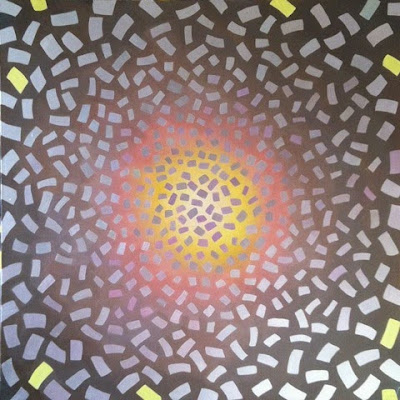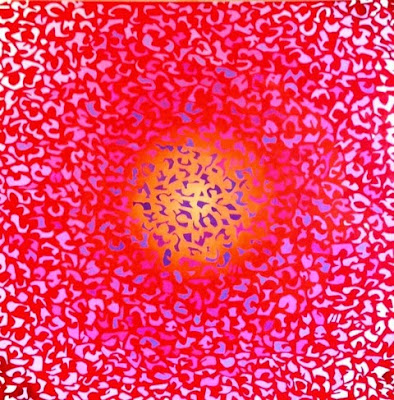COLOR CONTROL: THE PAINTINGS OF DEE SOLIN
There exist certain elements of
painterly description which are so central to the rigor of artifice that
they have flowed from one art form into all the rest, even into
contemporary technology which allows us a further degree of reflection
upon the idiosyncrasies of the natural world such as digital media. Such
elements are so essential to the practice of art that we cannot imagine
art not having them, nor a world that can be described without them.
Most central among these is Color. Just to say the word itself is to
speak volumes, while at the same time to be separated from adequate
knowledge as needed to explore its capacity for meaning. In the
paintings of Dee Solin we encounter an obsessive engagement with color
that operates in the stylistic milieu of painters like Julian Stanczak,
Carlos Cruz-Diez, Alfred Jensen, and Bridget Riley. Each of these
artists attended to color and structure not as naturally opposed aspects
of the same experiential, phenomenological universe, but as sections of
a system qualified only by the idiosyncrasy of intuition.
Color is, in effect, the speculative order of the known universe. We
cannot describe the world without it, and we cannot even imagine life
without it either. We could allude to scale--we could even describe an
object in minute detail, with exacting precision, but in the absence of
color it would be nearly impossible to say Tree, Sky, or Sea. Color in
the abstract is something else altogether, for without the utility of
verisimilitude, painting becomes more about making a statement, about
exploring forms, giving rise to an innate dynamism, and in some way
alluding to nature and the concrete or metaphysical elements by which it
is organized. Artists such as Willem De Kooning, Bradley Walker-Tomlin,
Paul Klee, and Wassily Kandisky have accomplished similar
constructions, in which the amassment of minute particulars, reduced in
individuality yet vastly multiplied and organized around a formal or
spatial concept that aptly describes how art contributes to the quality
and variety of aesthetic experience. Beauty itself cannot be used to
construct an entire universe, but it can aid us in achieving a more
enlightened world view.

Phenomenas, 2013, oil on canvas, 50 x 50 inches
Each of the paintings that Solin has made since circa 2009 adds
something to her oeuvre. In “Phenomenas” Solin paints a canvas filled
with white rectangular forms that resemble sheets of paper floating down
from the sky. These sheets are splayed out in an alternating pattern
that resembles the crystalline forms of falling snow, and they gather
ever more tightly toward the center of the canvas which is painted with
incandescent yellows, at if these blank glyphs were the minute yet
infinite particles of physical matter rushing like moths toward a very
immense flame. A similar work is “Eyes Wide Open” in which the particles
are more square and less accumulated, and they alternate between shades
of pink, pale purple, and gray-blue shale hovering over a red sky that
burns orange at its center.
In “Black Magic” Solin turns her iconographic glyphs into a chromatic
veneer that both illuminates and partially obscures the details of a
work which hints at a degree of verisimilitude. The supposed scene in
his painting suggests the wreckage of a downed or crashed airplane,
sitting half in shadow and half in sunshine. The upper of the two dark
forms suggests a military helicopter in flight. Whether any real
situation is in evidence, the mere suggestion of one is enough to start
the viewer’s mind racing into all sorts of narratives.

Sea of Remembering, 2013, oil on canvas, 50 x 50 inches
Her glyphs are most overt in a painting titled “Sea of Remembering” in
which they stand as the whole of the formal arrangement. In this case
they resemble colored confetti or fragments of leaves from trees. Here
we see them as actually possessing detail, a cartoonlike movement, and a
certain charismatic weight. They are painted over a background that is
black at its base and gradually lightens through shades of grey until
finally becoming a radiant white.

Crimson Odyssey, 2013, oil on canvas, 50 x 50 inches
In “Crimson Odyssey” we are presented with a new breed of painterliness,
for which Solin first painted the background, which ranges from white
to purple, and is laid over with a thick and bright lattice using a
scarlet red. Like “Phenomenas” it is arranged centrally, and in the
middle pulses the alien glow of some cosmic body, attracting much
smaller and darker colored fragments, glyphs dragged out of the overall
composition and into the core, where they will never be seen again.

In Dreams I Wish, 2013, oil on canvas, 50 x 50 inches
In two other canvases an oppositional aesthetic is likewise achieved,
with an amassment of the glyphs yet in formal terms that depart from the
works above. “Twilight Path” and “In Dreams I Wish” are both covered
from edge to edge with glyphs, with not even enough breathing room
between them, operating on two other principles: their interaction with
one another, stuffing the visual area of the canvas with competing reds,
yellows, and blue; and simultaneously breaking against larger forms
such as a Seusslike arabesque of an icily depicted ribbon that bends and
flows from the top of the image to the bottom, and in the second with
silhouettes of spheres also with icelike contours.

Yellow River Rocking, 2013, oil on canvas, 50 x 50 inches
Solin’s brand new works depart from all of these with the exception of
“Black Magic” due to a color use that borders on both dramaturgy and
symbolism, inferring a natural scene that carries with it a moody yet
prismatic quality. Works in this group include Yellow River Rocking,
Stairway to Heaven and The Tempest. Gone are the glyphs, gone is the
central organization and the symbolic reckoning with natural forms
beyond the reach of the everyday. Solin has already begun to develop a
new model for understanding how color speculates while the rational mind
does its best to fill in the gaps of causal knowledge with phenomena of
meaning. Color doesn’t only take up space, it controls how we see and
what we know.
Comments